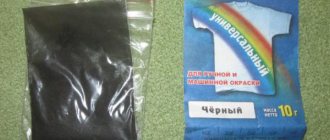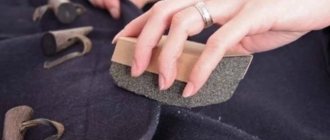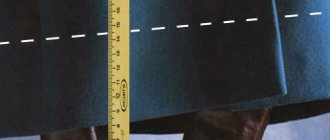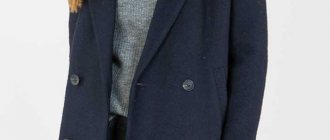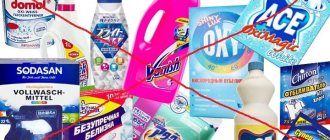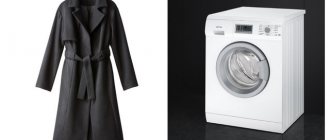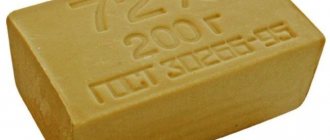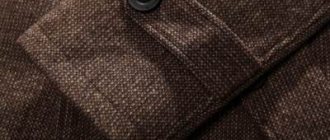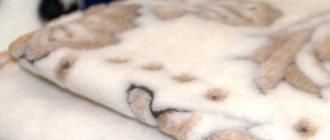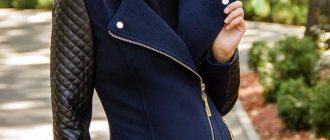How to clean a coat: drape, cashmere, wool, worries many. After all, a coat is a necessary and quite expensive thing, designed to be used for at least several seasons, and therefore care and cleaning are given a special place.
Caring for coats made of drape, wool, or cashmere must be done regularly. After all, this is a fabric on which dust, lint, threads, small debris, etc. happily settle. And the use of the above fabrics in outerwear is further aggravated by the fact that it is easy to catch all sorts of dirty stains on the street. Of course, it is best to trust the professionals and take the coat to the dry cleaner, but this is not always available. You can try washing your coat in the washing machine on a delicate cycle. Many people succeed in this, but the result does not always exceed expectations. After washing, the coat often looks worn, worn out and may not restore its structure after such a procedure. And oh, how I don’t want to take risks.
Cashmere coat
Cashmere is a delicate and delicate fabric. It should be worn as carefully and carefully as possible. And if cashmere is present in outerwear, then this is not an easy task.
You can refresh your cashmere coat at home using a regular soap solution, as well as a special cashmere brush, which can be easily purchased at a hardware store. This must be done extremely carefully. And if after this procedure there are creases left on the fabric, then, after hanging the product on hangers, you can place it over a bathtub with hot water so that the folds straighten out. Sticky rollers are used for dry brushing; they effectively remove stuck fur and hair.
A cashmere coat, so impressive and beautiful, can easily fall prey to a variety of stains: dirt, tea, coffee, oil stains. This cannot be avoided, so the question of how to clean a cashmere coat is quite relevant. You can try to remove the stains manually. To do this, you can go to a hardware store and choose special cleaning products there, with certain delicate ingredients that are suitable specifically for cashmere. Such stain removers contain active oxygen and do not contain chlorine. Such products are more likely to help get rid of stains. But there are also home methods, which also should not be ignored if there are already fresh “bloopers” on the cashmere coat:
- Ammonia. ½ tsp. ammonia with a teaspoon of glycerin are good in combating dirt stains, as well as tea and coffee. Glycerin is necessary here as a companion - without it, ammonia will simply be absorbed by the fabric and will not fulfill its direct functions of removing stains. Gently rub the stain with this mixture, then wash off with soapy water.
- Vinegar and alcohol. Their 1/1 solution is perfect for getting rid of beer stains. Rub the stain with soft gentle movements and then rinse with running water.
- Salt. It effectively fights wine stains. Sprinkle the surface of the stain with salt and leave it for a while to absorb. Then carefully, without touching the fabric next to the stain, remove the salt from the stain. And the final step is to blot the removal site with a swab with soapy water.
- Talc. This product is suitable for removing fresh oil stains, but only from a light cashmere coat. The greasy stain is treated with talc using the method of carefully driving it into the fabric. So the coat is left overnight, and in the morning the talc is removed from the surface with a paper towel.
How to wash a coat in a washing machine at home?
But when using any method of self-cleaning, you must be guided by two important rules. These are, firstly, the movements themselves, which should be soft, blotting, and careful. Under no circumstances should you rub desperately! And, secondly, the presence of a special brush for cashmere with textured fabric that will not damage the surface of the coat. Regular brushes will irrevocably ruin delicate cashmere.
How to remove a stain correctly
Stains on woolen fabrics should be removed from the edge to the middle. This will prevent the formation of a so-called “halo” - a leak. And it is advisable to remove stains fresh, both grease and oil. To remove the stain, you need to take a warm iron and several ordinary colorless paper napkins. Having applied napkins to both the front and the inside to form a layer, you should iron the fabric with a warm iron. You can remove stains in another way. For example, wipe with a swab dipped in a warm solution of ammonia (1 tablespoon) and detergent (1 tablespoon). You need to dilute alcohol and detergent in 200 grams of warm water. It is better to clean greasy stains remaining on the collar using a cotton swab moistened with a solution of salt and ammonia. For a glass of water you need 1 tbsp. a spoonful of salt and 1 teaspoon of ammonia.
When buying a wool coat, you should choose models with special impregnation that will protect against dirt and moisture. A good choice would be fabric with Storm System and Rain Systems protection. Such woolen fabric is reliably protected, and therefore is not afraid of either weather conditions or possible contamination. You won’t have to take care of it for a long time or often. Impregnated wool does not absorb moisture and dust, maintaining a fresh look for a long time. This fabric tolerates dry cleaning well. Therefore, if you do get your coat dirty, you can solve this problem very quickly.
Drape coat
A drape coat is a good option for protection from winds and chilly autumn. Drape is a fairly stiff woolen fabric with several layers. In order for it to last for a long time, it must be cleaned several times a season. It is best, of course, to do without a washing machine - this way the coat will retain its original appearance longer. Therefore, there is only one way out in this situation - dry cleaning.
There are several options for her work:
- A special microfiber brush does a good job of refreshing a drape coat. It is necessary to clean only in the direction of the pile. But, since drape is quite a tough fabric, you can clean it with a regular clothes brush.
- Rye bread crumbs are also a good help for cleaning. They are scattered on the surface of the coat and then rolled into large balls. The bread “carries away” all the dust and small particles. After this, you just need to go over the coat with a brush.
- A damp sponge is also a good option for express cleaning of stuck debris. You can use it to walk over the entire surface of the coat, in the direction of the pile.
5 ways to tidy up your sofa yourself
If the drape coat is quite dirty, then you can try using a soap solution using regular soap, or synthetic detergents that are intended only for cleaning wool. This solution is most often applied to heavily soiled areas or stains. Leave for a while and then remove with a clean damp cloth.
There is another problem area - the collar. It most often gets greasy and looks unkempt. To remove grease from the collar, use a solution of salt and ammonia, mixed ¼ respectively. But it’s important to first try this mixture on an inconspicuous area of the drape - what if it discolors? If not, you can safely wipe the collar with this solution.
Is it really possible to remove a small stain yourself?
Yes. Small splashes of mud can be allowed to dry and then brushed over with a soft brush. coffee or wine stain should be immediately blotted with a microfiber cloth or at least a napkin (just do not rub it under any circumstances), and then carefully try to remove it with a warm soapy solution. remove the greasy stain - you need to sprinkle it on the stain and leave it under a load overnight.
But we do not recommend trying to solve the problem in all possible ways at once. Of course, popular advice (using ammonia, gasoline or soda) may be useful, but there is a risk that along with the stain you will simply discolor everything around - and no dry cleaning will help with this.
Wool coat
A wool coat will not only keep you warm in autumn and winter, but will also show good operational skills. Wool can be different, but each type has one drawback: the vagaries of care.
Small particles in the form of dust, dirt, hair, and threads often collect on a woolen coat. This happens because this material is electrified. For simple dry cleaning, a soft-bristled brush is ideal.
But a wool coat requires washing - and it's best to wash it by hand. It's not as difficult as it seems. The action algorithm is simple:
- Dilute a special wool detergent, purchased in advance at the store, in warm water.
- Soak the coat for 5 minutes.
- Rinse the wool coat with clean cold water. Squeeze out, but very carefully. Do not twist under any circumstances!
- Place the coat on a towel and wrap it in it to remove excess moisture.
- Smooth out wrinkles, straighten. Leave until completely dry. While the coat is damp, the product cannot be hung on hangers, otherwise it will stretch out and lose its shape.
5 ways to quickly remove unpleasant smell from carpet
How to clean woolen outerwear if there is a stain on it? In this case, try the following simple steps:
- Soak a rag in warm water with a special wool product, apply the cloth to the stain, hold for several minutes so that the product is absorbed into the wool. Then rinse off the product with a clean damp cloth, then blot dry.
- Dilute ammonia with detergent 1/1, blot the stain with this solution (do not rub). Then rinse off with a damp towel.
- Hydrogen peroxide will help remove stains from alcoholic drinks. The algorithm is the same as the previous cases. But this should not be abused: long-term exposure of wool to such products is contraindicated; it can wear out.
Is it possible to wear wool and cashmere coats in rainy weather?
A little rain will not spoil or damage natural fabrics in any way, however, upon returning home, the item must be thoroughly dried, treated with a soft brush and carefully straightened, giving the product the correct shape. When wearing such an item, even with slight dampness and humidity, it is recommended to use a wide umbrella, being careful not to wet the fabric. In addition, it is advisable to reduce the time spent in light rain to a minimum if possible.
It is not recommended to wear these items of women's outerwear in heavy rain. Such weather is especially contraindicated for delicate and capricious cashmere products, which can easily lose their shape after being heavily wet.
Items made of wool are somewhat thicker and coarser than cashmere in terms of density and practical qualities, so a woolen item will withstand strong humidity more steadfastly. However, even in this case, it is recommended to use a product made from this material only in cases of extreme necessity.
In light rain, it is very undesirable to wear products with fur inserts that cannot be removed or unfastened. In addition, light-colored items may become stained or stained after heavy or light rain. It is usually not recommended to use products of this type in high humidity.
It is much better to wear practical models made of bolognese fabric, leather or raincoat in damp or rainy conditions.
However, if the choice is between cashmere and wool, dense wool items will withstand wet weather much better and more calmly than soft cashmere items.
Cleaning different stains
All dirt on the products is cleaned from the edges to the center, otherwise the work becomes noticeably more complicated. Stubborn stains can be removed by placing an absorbent patch on the back of the fabric.
Grease stains
You can get rid of greasy and greasy marks with a solution of gasoline, ammonia and soap. Fresh stains are sprinkled with talcum powder and starch.
Fuel oil
Fuel oil can be cleaned in the following ways:
- applying fir or eucalyptus oils and subsequent washing;
- caustic soda;
- laundry soap.
Rice. 10- Laundry soap to remove stains
Old stains can be removed with purified gasoline, car shampoo, ammonia, acetone or toluene. Apply the products to the dirt, hold for a couple of minutes and rinse with soapy water.
Dirt, dust, splashes
You can eliminate their remains with a paste of salt and warm water, a mixture of ammonia and hydrogen peroxide in equal proportions. Stubborn stains from street dirt or splashes from a puddle are removed with pure hydrogen peroxide, Antipyatin or any stain remover, for example Vanish.
Paraffin and wax
There are several ways to remove traces of a candle:
- Hot: steaming, ironing over a napkin.
- Cold: you can remove traces of a candle with alcohol and washing with soap, turpentine, gasoline, and solvent.
If the fabric allows, the stain can be scraped off with a razor blade or blunt knife, frozen in the freezer for a day, and chipped away.
Blood, sweat, vomit
You can eliminate sweat marks by soaking in laundry soap, Fairy soap or bleach, soda slurry, vinegar, aspirin, salt with or without ammonia. You can clean a blood stain by soaking it in a saline solution and washing it in cold water; if that doesn’t help, use hydrogen peroxide. You can get rid of traces of vomiting with cold water and soda, ammonia or Vanish.
Plasticine and chewing gum
Rice. 11 – Freezing gum with ice
You can remove traces of chewing gum and plasticine with vinegar. Pre-freeze the clothing and pin off the main part of the elastic. Stains from it are wiped off with stain remover, acetone or nail polish remover.
Soot and resin
Black sticky marks from fresh pine bark and soot stains are wiped off with kerosene. Apply to the stain for 20 minutes, and then rinse the clothes or wash with soap or powder.
Pen
Traces of ink are removed with a mixture of ammonia and baking soda in a glass of water. Soak the ballpoint pen stain in the solution, then wash well with laundry soap.
Whitewash, chalk, powder
A wet wipe with ethyl or ammonia or vodka will help against these substances. Leave it on the stain for 10 minutes, then sprinkle with baking soda and wash with warm water.
Animal fur and droppings
You can remove the hair of a cat, cat or dog with wet hands, combing the pile from top to bottom. You can also get rid of dog, cat hair, bird fluff or hairs of other animals with a sticky roller for clothes or ordinary tape. You can remove the remains of animal droppings, hair and lint with ammonia, salt and soda, potassium permanganate, and vinegar. Rub the stain with a weak solution of these products, and then wash in soapy water.
Solid oil
Dissolve 2 tbsp. l. vinegar in 500 ml of water, moisten a cotton pad and treat the stain. Then wash with washing powder or gel and dry the clothes.
Rice. 12 — Solid oil
Sticky spots
Sweet traces from syrup or jam can be removed with ordinary hot water - it dissolves the sugar. If the stain is old, use soap.
Lipstick, paint, oil
Cosmetic stains from foundation, pencil, powder or any other cosmetics, especially dried ones, are removed with alcohol, borax or turpentine. Fresh lipstick should be sprinkled with salt and washed with water and vinegar. Oil stains from machine oil, blue, ink or glue are removed with acetone. Dried glue can be removed with wine alcohol or glycerin.
Mold
Dissolve 2 tbsp in a liter of water. l. salt, add a little ammonia, boil and dip the contaminated clothing into the solution, then scrub with a brush. Hyposulfite, denatured alcohol, bleach, and acid whey from milk can also deal with mold. Apply them to the stains, wait 10-15 minutes and wash off with soap.
Paste
An effective way to remove ink is to use a solution of a teaspoon of ammonia in a glass of water. Soak a swab in the mixture, apply the paste stain with a ballpoint pen and rub. For greater effectiveness, warm the solution.
Liquids
Vinegar and alcohol will help remove stains from splashed water and get rid of streaks. Mix them in equal parts and treat the contaminated area. Traces of wine, beer and coffee are removed with a mixture of 2 parts pharmaceutical glycerin and 1 part ammonia.
Dirt, dust, splashes
You can clean the fabric from them with a soap solution and ammonia - add a tablespoon of soap and ammonia to 100 ml of warm water, saturate the fabric and treat the dirt, remove the residue with a damp cloth. This method is especially relevant in the fall if your coat has been splashed with mud from a puddle.
Rice. 13 – Splashes from a dirty puddle
Egg
Egg whites, as well as yolks, are removed with a soapy solution from water and dishwashing liquid. If its use does not help, add a little ammonia to the solution.
How to remove the smell of sweat from a coat under the armpits
Make a solution of 4 parts water, 1 part ammonia and 1 part ethyl alcohol. Mix well, spread over the lining and brush, then rinse with warm water.

